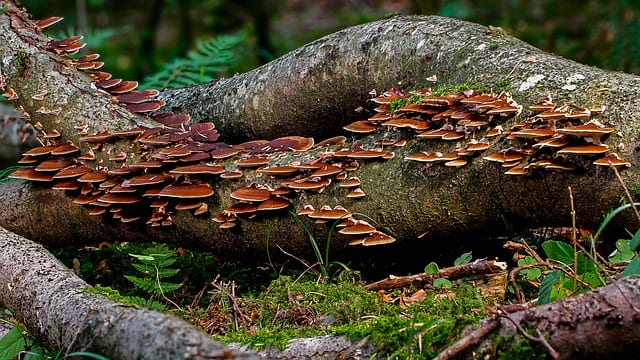
Fungi are eukaryotes, meaning that they have a well-organized structure. They are different from plants, animals, and even bacteria. They belong to a group that includes mushrooms, molds, and yeasts. The full extent of their biodiversity remains unknown, with research continuing to update records. It has been estimated that there could exist between 1.5 to 5 million different species of fungi on Earth, with an official classification of only 5% of them.
The study of fungi is known as mycology and they are genetically closer to animals rather than to plants. Fungi use organic matter as a source of energy, with carbohydrates being the preferred source of carbon. They can easily breakdown different types of carbohydrates like sucrose, glucose, and fructose. Fungi can also use cellulose, hemicellulose, and starches as sources of carbon.
Fungi that are saprotrophic in nature derive their nutrition from organic matter that is dead and decaying. Parasitic fungi derive their energy from organic matter that is still living, resulting in disease, especially in plants. A classic example is the rotting of fruits.
Benefits of Fungi
· Fungi are good sources of nutrition, especially mushrooms that are delicacies in certain parts of the world.
· Fungi are also used as leveling agents in bread (yeast) and are important in certain foods like beer, soy sauce and even wine.
· Fungi also play an important role in the degradation of dead animals, thereby playing a vital role in continuing the nutrient cycle.
· They are important in the development of antibiotics and have been in use for more than 20 years.
· Certain fungi are also useful as pesticides and are used to control the growth of unwanted plants. They are also sprayed on plants to prevent pest infestation and to prevent plant disease.
· Extracts of bioactive compounds from fungi are also used in certain psychotropic drugs, consumed for leisure or as a part of religious beliefs.
· Certain fungi are also known to attack plants and cause disease. The most common is the rice blast disease, which can damage vast tracks of crops, resulting in a lot of economic damage as well.
The most interesting aspect about fungi is that certain species can be alluring or highly beneficial, but little is known about them. Here are 8 fascinating fungi that are sure to captivate your imagination!
1) Bitter Oyster
This bioluminescent mushroom, called Panellus stipticus, is found in Asia, North America, Europe and Australia. They are called so as they resemble an oyster but they are bioluminescent.
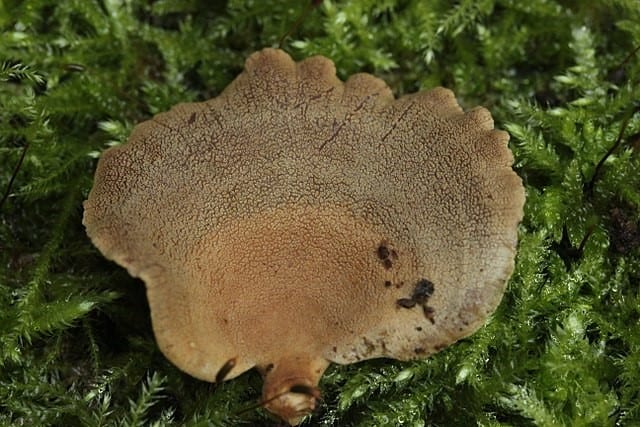
They grow in groups and are found in clumps, tightly packed together. They glow from the region of their gills and from the section at the junction of the cap and the stem.
It is hard to spot a bitter oyster as they grow in rotting wood. This includes growth in the stumps or trunks of Oak, Birch, bee, and other deciduous trees.
2) Blue Milk Mushroom
This species of fungus is widely distributed in the Eastern regions of North America and France. It grows on the ground in coniferous and deciduous forests.
This mushroom, also called Lactarius indigo, has a distinct indigo blue sap when cut. After a period of exposure to air, though, the sap changes to green color. It is edible and is found in the markets of China, Guatemala, and even Mexico.
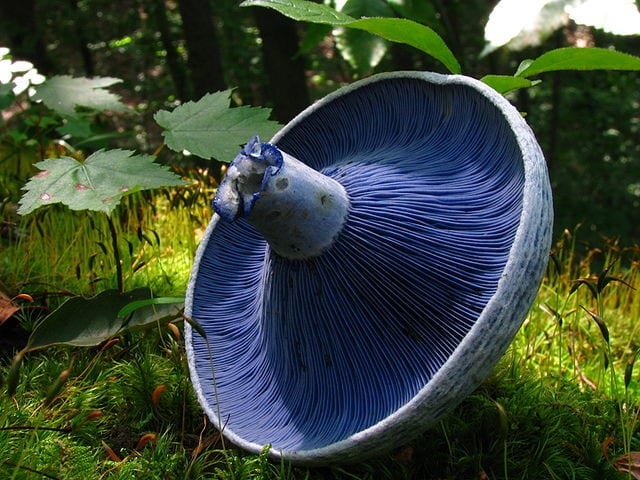
Their classic blue appearance gives them a unique appeal- however, their taste is of mediocre quality.
3) Violet Coral
Another mushroom that has a startling color, appealing visually, is the violet coral, or Clavaria zollingeri. This mushroom has violet to pink tubular bodies that are fragile but with the tips round and brown.
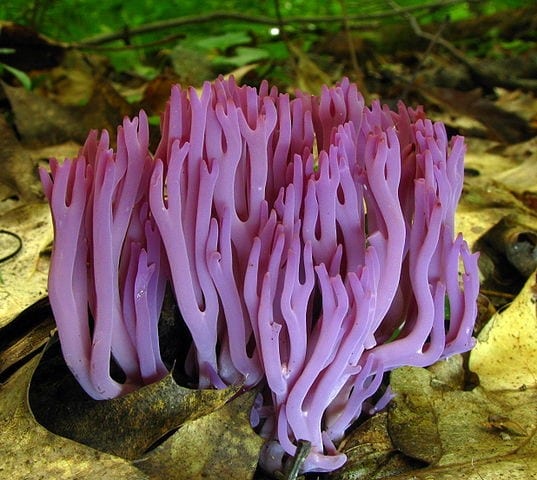
An important fact about this mushroom is that it derives nutrition by breaking down organic matter i.e., it is saprophytic. Therefore, they are found in the ground on a litter of wood or in the grasslands.
4) The Wrinkled Peach
This delightful mushroom is also known as the netter Rhodotus, wrinkled peach, officially Rhodotus palmatus, and even as rosy veincap.
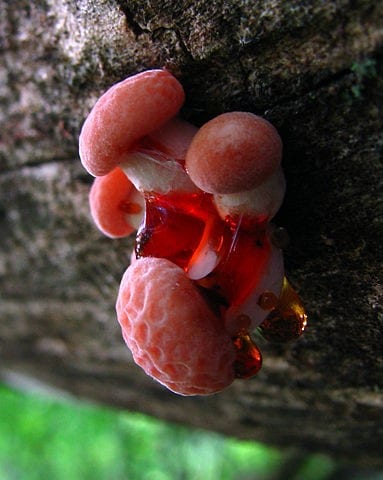
They have a distinct pink appearance when they are fully grown and mature. The wrinkled peach is usually found on hardwoods that have been left to rot. Their rubbery caps have a ridged and veined appearance, with the species found in Asia, Europe, North Africa, or even North America.
Variations in the availability in nutrition and sunlight affect the shape, color, and size of the fruit of the mushroom.
5) Golden Jelly Fungus
This is a common fungus that grows on dead wood, and is golden brown in color. Officially known as Tremella mesenterica, it has a lobed surface, which, when damp, is slimy to feel.
When it rains, this fungus turns into a thin film, growing back during the next rains. As it appears after a spell of rain, it is found in the crevices of tree bark.

They are prevalent in mixed forests and broad leaf forests, especially in Europe, Australia, America, and even in Africa.
Though they are bland to taste, these fungi are edible and are known to produce carbohydrates. This feature has brought in a lot of interest, pushing forward research initiatives.
6) Coral Fungi
These mushrooms are commonly called coral fungi as they resemble corals found underwater. Also known as Clavulinopsis corallinorosacea, the mushrooms are an attractive orange, red, or even yellow.
They are found in mature forests as they grow on decaying wood. They could exist both as a parasite as well as a commensal. These fungi are found commonly in England and Ireland, buried under decaying birch wood.
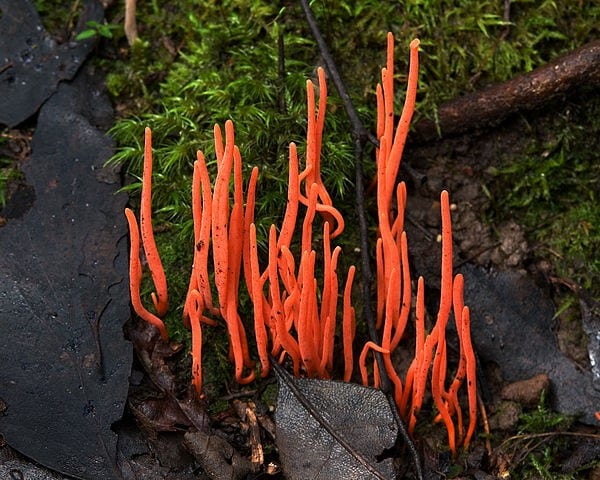
Other names for this fungus include finger fungi, spaghetti mushroom, or even worm mold. Their spores are a rusty brown or yellow in color.
7) Rounded Earthstar
This mushroom has a distinct bitter taste and is considered inedible. But that is not why it has made it to this list. The top part of this mushroom is in the shape of a star!
If that doesn’t make you starry-eyed, here is more about this interesting fungus. The distinct shape of this fungus is because of a buildup of calcium oxalate crystals. Another interesting feature is that there is a ridge that surrounds the central pore, adding to the visual appeal. It is also known as the star of the land in Brazil.
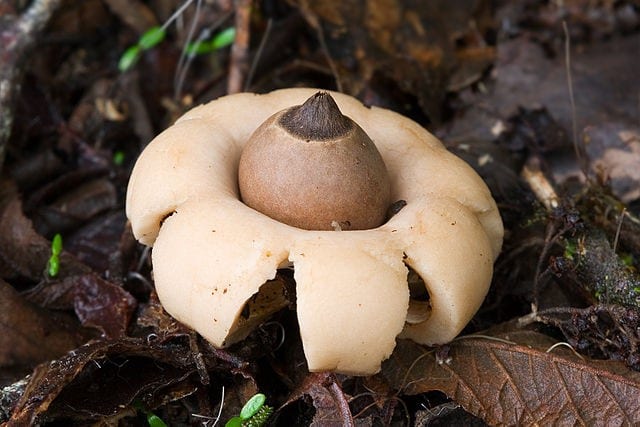
Geastrum saccatum, also known as the rounded earthstar, is found in wood that is rotting.
Though they are commonly found in the wild, their presence peaks during the bright summertime. They are mostly found in coniferous forests, underneath cedars.
8) Caesar’s Mushroom
This is a sought-after edible mushroom that is native to Africa and Europe. Caesar’s mushroom, or Amanita caesarea, was described first in the 1770s by one of Rome’s rulers, Giovanni Antonio Scopoli.
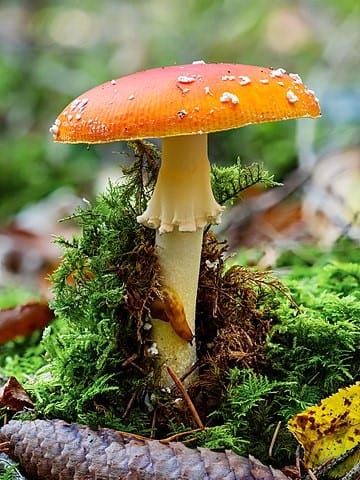
The fungi have an orange cap with gills that are yellow in color. Mushroom similar to these have been identified in India and America as well.
The Ancient Romans called these fungi Boletus, however, the name is now used for a different species of fungi. They are collected in large numbers from Southern Europe, especially in the Mediterranean belt. They are especially sought after when they are in the button mushroom stage or the ‘egg’ stage. Organic acids that are present in these fungi are extracted and used.
An interesting anecdote about this mushroom is that Agrippina, Roman emperor Claudius’ wife, is said to have tried to poison a meal consisting of Caesar’s mushroom. The meal was to be given to her husband, with the addition of the toxic Amanita phalloides. This was done to try and get her son Nero to become the emperor. The physician who was called in to treat the then emperor, ended up giving him a purgative instead of an antidote. Finally, Nero did become the emperor, and the mushroom continues to be a meal fit for the emperor!
Fungi are not only about unique appearances, and they are known for significant other properties as well. It was a study on fungi that brought in antibiotics. In 1928 Alexander Fleming discovered that the fungi Penicillium notatum continued to grow in a petri dish that had Staphylococcus aureus growing in it.
The Scottish bacteriologist discovered that there was a distinct ring around the fungus where there was no growth of the bacteria. This showed that there was something about the fungi that prevented Saureus from growing. Thus, the first antibiotic was isolated from a fungus, a discovery that completely revolutionized medicine. Fungi are also extensively used to derive vitamins, enzymes, and organic acids.
Fungi are also responsible for causing certain human diseases like ringworm, aspergillosis, athletes’ foot, and histoplasmosis. Normal commensals among humans include Candida albicans. This Is present in the colon, throat, and even in the human mouth but does not cause disease in healthy individuals. However, as age advances, and if the balance of micro-organisms is altered, it can result in Candidiasis. This condition, known as thrush, can lead to inflamed patches on the tongue.
Fungi have developed methods to snare micro-organisms like an amoeba, trapping them effectively, and sucking out their nutrition.
There are numerous other examples of fungi causing diseases in humans, but the edible ones are the ones that are popular. Some fungi have brilliant colors and unique characteristics, like the ones mentioned above, which make them captivating.

